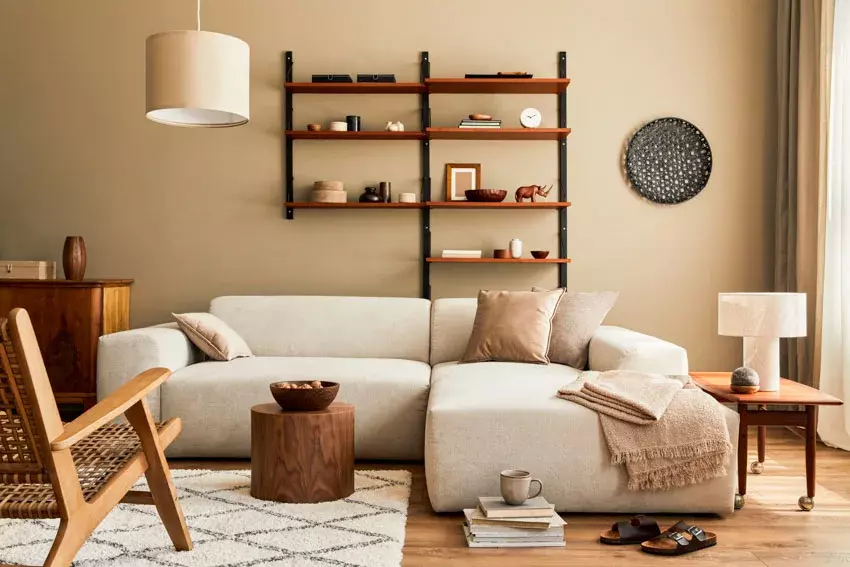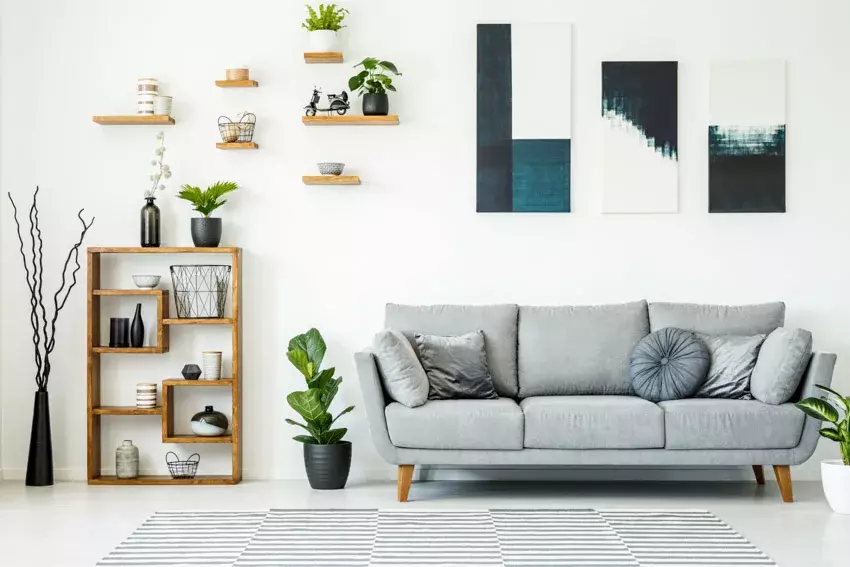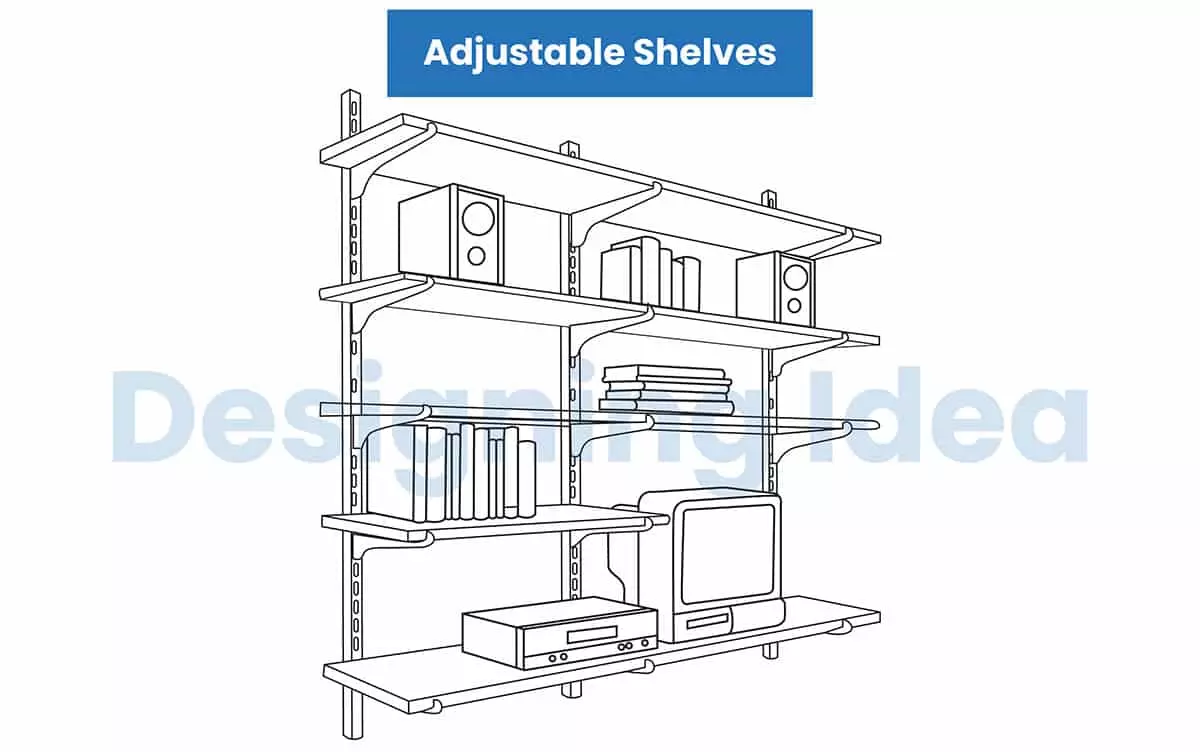Shelves are an essential element of interior design that cannot be substituted or removed. They provide storage space while allowing you to display and organize your favorite decorations and books. If you're looking for storage solutions, this complete guide will introduce you to the various types of shelves available.
Suspended Shelves (Fixed Bracket)
Fixed bracket shelves, also known as suspended shelves, have been popular for a long time. They are made up of separate brackets that are attached to the wall or vertical surface. The shelving is supported by the brackets, which are often made of metal. Suspended shelves come in a variety of materials, styles, and configurations, making them suitable for bedrooms, living rooms, and even workplaces.

Floating Shelves
Floating shelves are an elegant and beautiful shelving arrangement. These shelves are anchored to the wall, but the mounting hardware is hidden, giving them a floating appearance. They are typically made of wood veneer, which adds sophistication and a luxurious touch to any space. Floating shelves are versatile and can be used as both storage and interior decoration.

Adjustable Shelves
Vertical tracks, connectors, and the shelf itself form adjustable shelves. This type of shelving is highly adaptable and allows you to adjust the height of the shelves as needed. Adjustable shelves are commonly used in garages, as they provide versatility in storing items such as toolboxes, gardening tools, and clothing bins.

Freestanding Shelves
Freestanding shelves are not wall-mounted and can be placed anywhere in a room. They are typically rectangular with multiple shelves and require minimal installation. These shelves are available in various materials, including wood, steel, and aluminum. They are practical and modern, allowing you to showcase your accessories and decorations.

Ladder Shelves
Ladder shelves are designed to store books, toiletries, and other objects. They resemble a leaning ladder, with larger shelves at the bottom and smaller shelves at the top. Ladder shelves are portable and lightweight, making them easy to move and adapt to different spaces. They are ideal for smaller areas and are popular for their simplicity and versatility.

Cube Shelves
Cube shelves come in various shapes and sizes, with the number of cubes or sections distinguishing them. They are often made of wood, plastic, glass, metal, or laminate. Cube shelving can be modular, allowing you to build and customize the shelves as needed, or adjustable, with independently adjustable shelves. Cube shelves are versatile and can be used in any room to store and display items.

Rolling Shelves
Rolling shelving systems are a unique way to maximize space and organization. These shelves are mounted on rails and carriages, allowing them to move back and forth or side-to-side. Rolling shelves are often used in offices, schools, garages, and workshops to store items that would otherwise clutter the space. They are a practical and space-saving solution.

Corner Shelves
Corner shelves are an excellent way to maximize storage space in your home. They can be wall-hung or floor-based, depending on your needs and preferences. Corner shelves are available in a variety of shapes and patterns and can be adjustable or fixed. They are perfect for utilizing empty corner spaces and can add a stylish touch to your interior design.

Built-In Shelves
Built-in shelves are installed within nooks or empty corners of your home. They are simple to create using wooden planks or can be purchased as custom-made units. Built-in shelves are a versatile solution for maximizing storage space in your home. They can be used in various locations, including alcoves, recesses, and under stairs, to make the most of unused areas.

Hanging Shelves
Hanging shelves are a creative way to store and display your belongings. They can be hung from the ceiling or the underside of a cabinet, providing additional storage space without taking up floor space. Hanging shelves are commonly used in kitchens, schools, garages, and workshops to store items that would otherwise clutter the space. They are versatile and practical.

Pull Out Shelves
Pull-out shelves are installed with sliders and typically used as part of a closet or storage system. They allow for easy access to the items stored in the back of the shelf. Pull-out shelves are commonly used in kitchen cabinets, closets, and other storage systems. They are a convenient and space-saving solution for organizing your belongings.

Shoe Shelves
Shoe shelves are designed specifically for storing and organizing shoes. They come in various styles and can be freestanding or built-in. Shoe shelves are commonly found in bedroom closets, allowing you to easily access and showcase your shoe collection. They are practical and help keep your shoes organized and in good condition.

Decorative Shelves
Decorative shelves are a stylish addition to any room. They can be used as focal points to showcase art, books, and other decorative items. Decorative shelves come in various designs, including pedestal, cubby, stacked, and single-style shelves. They can be placed above desks, fireplaces, couches, and in unused corners to create a fashionable vignette and enhance the overall space.

Under Stairs Shelves
The space under the stairs is often unused but can be transformed into valuable storage space. Under stairs shelves can be customized to fit the dimensions of the available space and can be used to store various items. They are both practical and visually appealing, making use of an otherwise wasted space in your home.

Self-Adhesive Shelves
Self-adhesive shelves are affordable and easy to install. They are typically made of lightweight materials like thin wood or plastic and can be directly adhered to the walls using self-adhesive tapes. Self-adhesive shelves are ideal for small storage needs and can be used in various rooms, including kitchens, bathrooms, and bedrooms.

Shelving Materials
There are various materials used for shelves, each with its own advantages and aesthetic appeal.
- Metal: Metal shelves are strong, durable, and easy to clean, making them suitable for offices, retail stores, and warehouses.
- Wire Shelving: Wire shelving is popular in commercial settings and offers good visibility and airflow.
- Wood: Wood is the most commonly used material for shelves. It is durable, versatile, and adds a touch of elegance to any space.
- Glass: Glass shelves are aesthetically pleasing and are often used in bathrooms and living rooms to display decorations.
- Plastic/Acrylic: Plastic shelves are lightweight and versatile, commonly used in children's rooms and home organizing units.

Types of Shelving Brackets
Shelving brackets play a crucial role in supporting shelves and determining their weight capacity. Here are some common types of shelving brackets:
- Angle Bracket: L-shaped brackets used to attach furniture together.
- Wood Bracket: Wood brackets add a rustic aesthetic to shelves.
- Heavy-Duty Bracket: Designed for heavy furniture and offers extra support.
- Floating Bracket: Provides a hidden and modern floating appearance for shelves.
- Decorative Shelf Bracket: Enhances the aesthetic appeal of shelves.
- Lip Bracket: Prevents items from sliding off the edge of the shelf.
- Brass Bracket: Offers a modern or antique look, depending on the finish.
- Folding Bracket: Allows shelves to be folded when not in use.
- Adjustable Bracket: Can be adjusted to accommodate the weight of items on the shelf.
- Pipe Shelf Bracket: Made from pipes and commonly used in industrial settings.

How to Hang Shelves on Drywall
Hanging shelves on drywall requires proper installation for stability and safety. Here's a step-by-step guide:
- Measure and mark the position of the shelf on the wall.
- Attach brackets to the shelf and mark the position of the bracket holes on the wall.
- Drill starter holes for the screws or toggle bolts.
- Insert the screws or toggle bolts into the starter holes and tighten them.
- Attach the shelf to the brackets using screws or other appropriate fasteners.
How High and Far Apart to Hang Shelves
The height and spacing of shelves depend on personal preference and the purpose of the shelves. Generally, shelves should be hung at eye level or 4 to 5 feet from the ground. The spacing between shelves can vary depending on the items being stored but typically ranges from 7 to 15 inches.
Weight Capacity of Shelves
The weight capacity of shelves depends on the brackets and the strength of the material used. It is important to consult the manufacturer's specifications for the maximum weight capacity of your shelves. In general, shelves can hold anywhere from 20 to 600 pounds or more, depending on the design and installation.
Conclusion
Shelves are essential for storage and organization in every home. Whether you prefer suspended shelves, floating shelves, adjustable shelves, or any other type, there are numerous options available to suit your needs and style. Consider the materials, brackets, and installation techniques to ensure the durability and stability of your shelves. With the right shelves, you can enhance your home's functionality and aesthetics.









